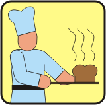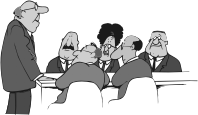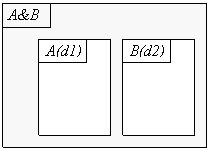
Objects. The object is an or concrete material object (as that: the car, the building, money and other things), or set of the information (music, inventions, writing, etc.), but without connection with the concrete owner.
Property relations can be described in the form of graphical model. For this purpose we shall determine three initial notions, they are - "object",Ā "owner" and "possession".

Objects. The object is an or concrete material object (as that: the car, the building, money and other things), or set of the information (music, inventions, writing, etc.), but without connection with the concrete owner. |
Possession (ownership). Possession joins the owner with objects. As a result of such joining objects become the property. We shall image possession of the concrete owner as a covering rectangular which unites in itself and the concrete owner (on the scheme he is named └) and a full set of all objects which belong to this owner (they are represented as points p, q and r). The surface of this rectangular can be understood as area of owner possession - all the objects which are being inside, are accessible to the owner for using (Fig. 1).

Fig. 1 Owner A owns objects p, q and r |
In a schematic form possession is represented quite compact, however in real life the contents of possession has no certain borders at all: the property can be in the different remote places, but the main thing - the area of possession is inaccessible for observations at all. Nevertheless such graphic representation of possession is rather convenient for the theoretical analysis: it enables to represent all owners: a usual citizen, a family, a public organization, a business firm or even the state - absolutely identical.
Possession also can be represented algebraically. In this case it is possible to write down the possession of objects p, q and r by owner A in the form - p└, q└, r└.
The property using are intentional (i.e. operated by the owner) changes of objects conditions. Concrete using acts can be diversified: and various changes of the object form, and connection of different objects in something the whole, and change in space position.

Fig. 2 Using act. Object p1 is converted to condition p2 |
Let us assume that baker (owner A) has put the dough into the oven (the initial condition of object is p1) and, having waited when bread will bake, takes out ready loaf (the final condition is p2). On the scheme the way how baker has influenced on object is shown by the arrow directed from the initial object condition to final (Fig. 2).
This using act can be designated by one symbol u, or it is possible to write down in the form as algebraic operation (it is represented as arrow)
u└ = ( p1 → p2 ) └
That means - as a result of the using actĀ u└ the owner's A object p1Ā has been converted to the condition p2.
Whichever using acts are made by owner with his property, it is changes only the conditions of objects, but not their belonging. Possession of objects can be changed only as result of interaction with exterior owners.
Voluntary interaction is concerted changes of possession of cooperating owners. Schematically voluntary interaction is represented by the arrows showing direction of possession change.

Fig. 3 Voluntary interaction between A and B owners (property moving is represented by arrows) |
 For example, the ownerĀ A comes into the shop and buys there for money (object $q) the book (object p) from the owner B (Fig. 3). On the scheme it is visible, as in the given interaction act the contents of property are changed at both owners: the object $q leaves from the property of the owner A, but his possession is replenished with object p; and at owner B, on the contrary: the property is replenished with object $q, but object p leaves his possession.
For example, the ownerĀ A comes into the shop and buys there for money (object $q) the book (object p) from the owner B (Fig. 3). On the scheme it is visible, as in the given interaction act the contents of property are changed at both owners: the object $q leaves from the property of the owner A, but his possession is replenished with object p; and at owner B, on the contrary: the property is replenished with object $q, but object p leaves his possession.
Moving process of objects from one owner to another is not stretch in time, it occurs instantly, without the intermediate stages. Objects during the moment of possession change may not change their spatial position. The property movements displayed on the scheme have only theoretical but not mechanical meaning.
Unrestricted possession. Some of objects can be in unrestricted possession. Unrestrictedness means, that the owner can make with that object absolutely any actions, in particular: to move anywhere, to transmit to any exterior owner in any terms, to not use object, to spoil or even to destroy it completely.
Restricted possession. Unrestricted possession can be divided by the owner into areas - the restricted possession. It occurs when at interactions the owners transmit objects in some restrictive frames of possession (on time, in a using place, on interactions conditions with other owners, etc.). Thus, the possession of one object can be divided into independent possessions between several owners.

Fig. 4 The moving act of object p to restricted possession α of owner A |
For example, the owner S (suppose, the state) has transmitted object p (parcel of land) to owner A (farmer) in the restricted possession (rent). It means that both owners A and S possess the one object p. More particularly, A can sow cultures on p, irrigate crops, harvest, sell p to exterior owner, etc. We shall designate such restricted possession (area) of owner A over object p by symbol α (Fig. 4). Thus owner's A possession of the object p can be written down as αpA.

Fig. 5 Owners A and S own one object p in restrictions α and β |
On the other hand, the former owner S also now can be restricted on possession of this object p. We shall designate this possession restriction of the owner S by symbol β (Fig. 5). Full possession of the given object p consists of two possessions areas:
p = α pA + β pS.
Let's note basic sense of the restricted possession - owners A and S own the same object p not together, but separately. Each of the restricted owners, being in the certain restricted frames, uses the object p only under the own wish without dependence from desires of other restricted owner.
Any owner has next abilities:
The person-owner (intellect). In theoretical sense the person-owner is not appearance of the concrete person but only its mental faculties - ability to feel the objective world and to influence it. In a human civilization the human minds are elementary owners.
Compound owners. By means of interactions the elementary owners can create compound owners who are consist of combination of two or more owners. Depending of a kind of combination of component owners, the compound owners can be one of two kinds - collectives or subdivisions:
Collectives consist of two or more owners - co-owners, - which own property on shared base. Combination of co-owners in collective occurs by means of the coefficient named share. We shall designate a share by symbol λ - its values lay in an interval 0≤ λ ≤1, where 1 - sum of all shares.
The more the concrete co-owner has λ value, the greater share in collective property he owns. Investigating λ values, it is possible to find out two boundary cases. When the co-owner share value decreases to zero (λ =0) its means that he is not the co-owner at all. If the share value rises up to unit (λ =1) - its means this co-owner is the single owner of all collective property.
Let's consider an example (Fig. 6). We shall admit, there is a stock-company C, where all shares belong to two shareholders (co-owners) - A and B. The shareholder A owns 70% of shares (λ└=0,7), and the shareholder B owns 30% of shares (λ┬=0,3). Thus, the collective C - it is 0,7A + 0,3B. |
 Owners can create inside of themselves new owners whom they will own. We shall name the owner who owns other owner the chief , and the owner who is in possession - subdivision.
ĀSchematically we shall represent subdivision as the owner inside of the chief property.
Owners can create inside of themselves new owners whom they will own. We shall name the owner who owns other owner the chief , and the owner who is in possession - subdivision.
ĀSchematically we shall represent subdivision as the owner inside of the chief property.
The subdivision simultaneously is both - the owner and the object of possession. The possession of the subdivision consists in definition to it the purposes which it will realize in practice - we shall name such possession control. The subdivision owns the property not completely, but restrictedly, we shall name such restricted possession - execution.

Fig. 7 Chief A and his subdivision B |
Example. The person (owner A) has created the manufacturing firm (subdivision B). Now A is the chief of subdivision B - that is A controls ┬, and ┬ obey to A. Let p - the property of subdivision B: machine tools, materials, finished goods - the subdivision B owns them restricted - only executes the purposes that are set by the chief A. Simultaneously the same objects p belong to A as to the chief, but already completely, without any restrictions.. We shall notice, the objects of the property related by the owner A to a personal property: as the house, the car, the TV, etc. - (we shall designate r), do not belong to subdivision B Ā(Fig. 7).
The subdivision is formed every time when one owner (chief), sets the purposes for implementation to some exterior owner - the executor. Subdivisions can be very steady in time though executors can vary. For example, when executive director leaves his post, his place is occupied with other person, and the enterprise as the subdivision, remains constant.
Let, the owner A creates subdivision D and allocates there property p (Fig. 8). For this purpose A cooperates with exterior owner E (executor) that E will obey to him (execute his purposes). Let d - a post, as a set of characteristic actions executed by subdivision D. Thus E, occupying post d, becomes executer of subdivision D.
|
The subdivision is a result of obey of executor to his chief. Shall designate operation of obey by symbol "." (point). Thus, subdivision D can be described by the formula:
D = A.E
Subdivisions, being owners, also can create inside of themselves other subdivisions in relation to which they will be chiefs (Fig. 8). Thus, between owners there can be a whole hierarchy of possessions in the form of the subordinations relations. If to examine only that subdivisions, which united in steady subordination hierarchy they create the administrative machine. |
The pictured character q cannot belong neither to the writer A, nor to artist B as during writing of a fairy tale and its illustration both of them belonged to publishing house K as executors. As both - the writer A and the artist B - belonged K, means, the result of their acts of using - the pictured character q - also belongs K.
Both owners - and A and L - own apartment simultaneously, but each of them in their own restricted area. Restriction of possession A - to not be inside apartment p during time of rent. Restrictions of possession L - to release the apartment p after term of rent.
 As A owns 100 % of shares of the company B, then, the owner of the company A simultaneously is the owner of the company B. Hence, both companies - A and B - are in possession of the same owner - we shall name him A&B. Directors of both companies A and B (we shall designate them d1 and d2 accordingly) also belong to the owner └&┬ as all other property.
As A owns 100 % of shares of the company B, then, the owner of the company A simultaneously is the owner of the company B. Hence, both companies - A and B - are in possession of the same owner - we shall name him A&B. Directors of both companies A and B (we shall designate them d1 and d2 accordingly) also belong to the owner └&┬ as all other property.
Owner └&┬ is the one who controls even one of directors d1 or d2, - as the director of other company also belongs └&┬ automatically. If at least one of directors is controlled by nobody - that he is the real owner └&┬ who owns both companies.
| Property graphical model - it is summary of Axiomatic property theory |